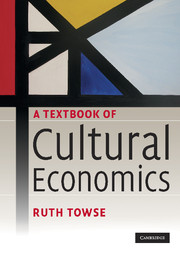Book contents
- Frontmatter
- Contents
- List of figures
- List of tables
- List of boxes
- List of abbreviations
- Preface
- Part I General issues in cultural economics
- Part II The ‘traditional’ economics of the arts and heritage
- Part III Artists' labour markets and copyright
- Part IV The creative industries
- Introduction
- 14 Economics of creative industries
- 15 Economics of the music industry
- 16 Economics of the film industry
- 17 Economics of broadcasting
- 18 Economics of book publishing
- 19 Economics of festivals, creative cities and cultural tourism
- Part V Conclusion and exercises and problems
- References
- Index
16 - Economics of the film industry
- Frontmatter
- Contents
- List of figures
- List of tables
- List of boxes
- List of abbreviations
- Preface
- Part I General issues in cultural economics
- Part II The ‘traditional’ economics of the arts and heritage
- Part III Artists' labour markets and copyright
- Part IV The creative industries
- Introduction
- 14 Economics of creative industries
- 15 Economics of the music industry
- 16 Economics of the film industry
- 17 Economics of broadcasting
- 18 Economics of book publishing
- 19 Economics of festivals, creative cities and cultural tourism
- Part V Conclusion and exercises and problems
- References
- Index
Summary
In this chapter, I analyse film production and distribution as well as the cinema industry. The film or motion picture industry has many component parts, and its economic organisation is accordingly complex. Film production requires the sequential co-ordination of many people with artistic and technical skills, often working to a fixed time schedule (Caves' ‘motley crew’ and ‘time flies’ features; see box 14. 5); greater co-ordination problems and higher sunk costs mean more contracting and therefore higher transaction costs. Although many of the economic principles are the same as for other creative industries, the huge outlays of investment that are associated with feature film production make for some significant differences in the way the film industry is organised. Nevertheless, a similar framework to that for the music industry is used to analyse the structure of the film industry from film production to cinema (movie theatre) exhibition, which is the primary market, and then move on to consider the secondary market for film on television and in video and DVD formats, as well as the impact of digitalisation and the internet.
Technical change
The film industry is more or less 100 years old and was international from the start, with the development of and competition between technologies and ideas flowing between Australia, France, England and the United States. Like other new industries, it took some time before the content and delivery technologies of moving pictures settled into a standard pattern, and at first films were exhibited in temporary spaces.
- Type
- Chapter
- Information
- A Textbook of Cultural Economics , pp. 434 - 461Publisher: Cambridge University PressPrint publication year: 2010



